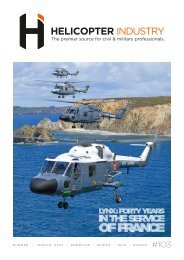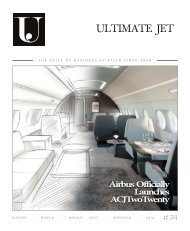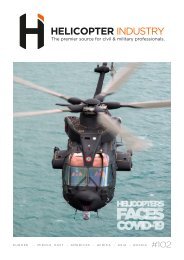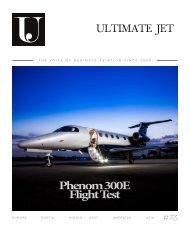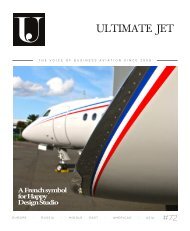Magazine Helicopter Industry #101
- No tags were found...
Create successful ePaper yourself
Turn your PDF publications into a flip-book with our unique Google optimized e-Paper software.
HELICOPTER INDUSTRY I FLIGHTEST I<br />
THE STARTING PHASE<br />
Although our helicopter is in the middle of its scheduled daily<br />
flight program, some adjustments and checks are required.<br />
Eight levels of adjustment allow to select the right distance<br />
between the seat cushion and the pedals, so pilots of<br />
different sizes will easily find the most comfortable position.<br />
The engine and rotor are still running, which eliminates the<br />
need for a full start-up procedure, which however deserves<br />
to be described here.<br />
The pilot in command, once the pre-flight visit has been<br />
made, puts the battery on, checks that all the indicator lights<br />
are working, confirms that the fuel level indicated on board<br />
is the same as that which had been previously checked with<br />
a manual gauge during the outdoor pre-flight. If the engine<br />
is started for the first time of the day, the engine must heat<br />
until the oil temperature reach its nominal operating level of<br />
200°F. But if the engine, at the time of starting, is already<br />
hot, the pilot plays on the booster, avoiding admitting too<br />
much fuel by rotating the gas throttle located at the top of<br />
the collective lever.<br />
If the engine is cold, it will overfill it by opening the full<br />
throttle. The fuel pump is turned on and the mixture control<br />
on full rich for eight seconds. Then, the pump is switched off<br />
and the mixture reduced to «lean».<br />
The start sequence is activated by pressing a master switch.<br />
Finally, the starter is actuated using another button located<br />
on the collective lever. Two or three seconds are enough to<br />
launch the four cylinders of the 225 shp Lycoming HIO-360<br />
turbocharged.<br />
Maintained at 1,500 rpm, the engine begins to heat. While<br />
waiting for the nominal 200°F, the clutch is made using a<br />
lever to synchronize the rotation of the rotor and that of the<br />
engine. Then, the engine set at 2,300 rpm, the oil temperature<br />
rises quickly to 80°F.<br />
CHECKS AND PRESETS<br />
At this temperature, the pilot set the engine to its nominal<br />
speed of 3,050 rpm. He then checks the two magnetos<br />
the cylinders are powered by two spark plugs each. The<br />
magnetos are cut one after the other. At each cut, a loss<br />
of 100 to 125 rpm is tolerated. With the two magnetos in<br />
operation again, the pilot tests the response of the freewheel<br />
by cutting off abruptly the power. The main rotor must<br />
continue to rotate normally, when the engine revolutions have<br />
dropped. The desynchronization of the engine revolution and<br />
rotor revolution indicators having been checked, the engine<br />
is set back to the initial speed of 3050 rpm. The turbocharger<br />
requires to adjust the mixture, in order to prevent the exhaust<br />
gases from reaching a too high temperature. On the flight<br />
deck, a dial indicates the fuel mixture. We therefore reduce<br />
a little the mixture, adjusting the consumption to 65 or 70<br />
pounds/hour so as to limit the temperature of the exhaust<br />
gases (TIT)to 1500 ° F.<br />
Take-off is now imminent. Belts fastened, doors closed, all<br />
nominal parameters checked and no obstacles around. A<br />
pull on the collective allows us to hover at one meter from<br />
the ground. The amplitude on the pedals is normal, without<br />
exaggeration. The movement of the foot alone (and not of<br />
the leg) is enough to steer the nose of the aircraft in the right<br />
direction. A glance at the exhaust temperature confirms<br />
that the preset is correct. The balance of the helicopter is<br />
good. We are now moving slowly towards the take-off area.<br />
On a piston engine, the power indicator corresponds to the<br />
manifold pressure applied to the engine. When hovering, the<br />
pressure gauge on the Enstrom is 26 to 27 inches. But with<br />
the turbocharger, during the takeoff phase, we will be able to<br />
increase the manifold pressure up to 39 inches.<br />
We are ready and lined-up for takeoff. A tiny pressure on<br />
the cyclic, forward, triggers our longitudinal movement and<br />
quickly brings us to the hanging speed - the one where the<br />
helicopter flies outside the ground effect. n<br />
HI I 70




